Yves Fey's Blog, page 2
May 17, 2014
Wonderful Indie Reader Review
Here’s a great new review for my mystery from INDIE READER. This month I’m giving away codes for downloads of my new Audible audiobook of FLOATS THE DARK SHADOW, read by Hollie Jackson, so I hope the review will tempt you to come leave a comment on any post at Chocolate, Cats and Crime, or on any page of my YvesFey . com website.
Rating: 4.5 stars
A policeman in late nineteenth-century Paris tries to track down a vicious child murderer who may be linked to an eccentric group of artists.
The year is 1897, and Inspecteur Michel Devaux of the Sûreté is investigating the disappearance of several young children, mostly boys. Strange winged crosses appear where they have been taken, and there are hints of a link to Satanic rituals. Devaux’s investigation quickly leads him to the Revenants, a group of artists and poets dedicated to creative exploration of life and death, rebellion and truth, darkness and light. Theodora Faraday, an American painter living in Paris, and a member of the Revenants, is horrified by the killings and concerned for her beloved cousin, Averill Charron, a key suspect. Determined to do what she can, she takes up the case on her own – but even her courage and daring may not be enough to save her from a madman’s horrific fantasy.
FLOATS THE DARK SHADOW is a disturbingly- but beautifully-crafted tale that will send chills down the reader’s spine even as it fascinates. Fey has a way with words that matches her heroine’s skill with paints, setting the scene and invoking emotion with vigor and artistic sense. The setting feels true-to-life and three-dimensional – the world of nineteenth-century Paris blooms around the reader, scents and textures, politics and attitudes alike. The plot is vigorous and action-filled without losing coherence or intelligence, and the lead characters are all fully human, fully believable, and in their own ways understandable. Every single person in the book has motivations and backgrounds that shape and move them- some may be sadistic, vicious and vile, but none are ever flat or uninteresting. The ending, while providing a satisfying resolution, retains a certain yearning complexity that leaves the reader hoping for the characters’ stories to be continued in further books – and honestly, it’s hard to let go of such interesting company.
The squeamish reader may not find this a comfortable read, given that it involves, among other evils, the torture and murders of young children, and the author’s skill with words and scene-setting only heightens the horror. There are places, perhaps, where the story drifts a bit too much into the mystical for some readers’ liking, especially with the Tarot cards, but that is naturally a matter of opinion.
FLOATS THE DARK SHADOW is a chilling, dark, richly complex, and thoroughly engrossing historical mystery – with a shiver of horror to it.
Reviewed by Catherine Langrehr for IndieReader
May 5, 2014
All the King’s Men: Breaking the Rules with Brilliance
Every week May I’ll be giving away four Audible audiobook codes to my mystery, Floats the Dark Shadow, narrated by Hollie Jackson. That’s twenty in all. Comment here on my blog on any blog post or any of my website pages to enter. Be sure and leave a way to contact you. Do you have a favorite audio book to praise? I book you love that breaks the rules?
I am guest blogging today on DV Berkom’s Blog. My post is on Breaking All Elmore Leonard’s Rules. http://dvberkom.wordpress.com/
Those rules were written primarily for genre fiction, but the opening of Robert Penn Warren’s Pulitzer Prize winning masterpiece is unusual for a literature as well. It breaks some far broader rules. That and recently listening to Michael Emerson’s superb reading of the novel motivated me to write this post.
All the King’s Men is one of the few books I return to again and again. The only work of American literature I’ve read more often is The Great Gatsby. And, as the end of The Great Gatsby is possibly my favorite ending of any book, the first page of All the King’s Men is one of my all-time favorites openings. Its hypnotic, lyrical realism, its evocation of time and place and mood, is never ending magic. Hearing Michael Emerson’s fabulous narration of the book, I realized that that first page is not just gorgeous and atmospheric. That first page, the mythical drive down the highway mirrors the drive that Jack Burden will take through the novel, tells you that the book is about Fate, and Blindness to Fate, and Death. It’s marked with a “metal square painted white and on it in black a skull and crossbones.”
But that’s not all.
“Later on love vine will climb up it, out of the weeds.”
Hear Emerson read here: http://www.amazon.com/All-the-Kings-Men/dp/B000IJ7IF8/
Breaking rules. We drive on, and that drive, part real, part metaphysical, follows with backstory, and not even character backstory, but backstory of Mason City. It gives us Willie Stark’s world and the understanding of how he’ll rise to power within it. The second part of the chapter takes us to Burden’s Landing. Jack Burden’s world, though he’s doing his best to live in Willie’s. In each, we’re introduced or at least given a mention of the cast important to Willie and to Jack. Who loves them, and who they love. And those two places, those two worlds, Mason City and Burden’s Landing, are, in essence, characters who will fight to the death.
Breaking rules. Our narrator does not identify himself for 23 pages. The first chapter is 70 pages, almost a tenth of the book. From the way it moves I’d have guessed, as my husband did, that it was half that long, but I bothered to find the page count because I did know that our narrator is anonymous for a long time, when he could easily have been named for the reader. But Jack Burden sets himself apart, and it’s a stunning way to make you feel that. He begins as the voyeur on the events. We know he works for the “Boss.” He’s in the important first car with the Boss, but his role is ambiguous. He does little stuff—helps the Boss’ wife out of the car, helps haul the aging, foul-breathed dog close enough to the Boss for the photo op. But he chose the farm for the photo op. And the Boss seeks him out to share a drink and talk. Like a friend. And back when we met Willie for the first time, when we learned who was telling us the story, we learned Jack Burden used to be a political reporter. He did a lot of digging.
But who is the Boss? If you are reading the book you probably know that he is a fictional version of Louisiana’s Huey Long), but who is Willie Stark? The first chapter shows us in a myriad of ways. We see who Willie is from who he is with. We find out who Willie might have been, if he was born rich and not as smart as he is, because we see his son first and see a detestable arrogance that is mirrored in their physical descriptions. But Willie is smart, and it makes a difference. He was always smart, but he was also naïve. We see him when Jack Burden first met him, and that’s when we name Jack for the first time, when he meets idealistic Willie in his cheap seersucker suit. Willie Stark who married the school teacher. We see that Tiny Duffy, who came out of the womb a politician, thinks it inconceivable that Willie is one. He exhibits not one tell-tale sign of the beast. But now Tiny Duffy works for the Boss. That Willie wanted to make a difference. It took a different Willie to do it. We see the Boss play at being just one of the folks to a dusty crowd that worships him. At his father’s farm, we see that he’s outgrown his roots, that he’s at the old farm as much for a photo op as to see his father. We see he’s outgrown the wife he used to adore. We see who he was, who he is, and most of us know that the skull and crossbones is waiting for him.
And then we drive to Burden’s Landing. And Jack the ambiguous sideliner is suddenly pinned dead center in the web. He’s the Prodigal Son returned. And the Judas. He’s the boss’ boy, but the boss is happy to serve him a drink, as long as it’s all part of the charade. It’s in Burden’s Landing, the world he’s betrayed, that we see that Jack Burden is a jack-of-all-trades henchman for the Boss, the king. He digs. He digs for dirt. But Jack could leave any time if he wanted to. He wants to be where he is. Willfully blind Jack loves looking for other people’s truth. When he doesn’t hate it. He has no idea how much he’s going to hate it.
The first chapter begins with a drive down a hot summer road, it ends that night with another drive, in the dark and into the dark. When you reach the end of that first chapter, you’ll find that the whole book was encapsulated within it, more fully and intricately than in that beautiful opening page. The important players have been named, their roles declared, and their fates pronounced. The skull and cross bones marked.
And that’s the beginning.
Floats the Dark Shadow Audio Book Giveaway
From now until the first of June, you can win an Audible audio book of my Belle Époque mystery, Floats the Dark Shadow, narrated by Hollie Jackson. Four codes a week will be given away, with the winners chosen at random every Monday. I usually enlist the help of my cats and small crumpled balls of paper. Just make a comment here on this or any other post. You can also make a comment here about any page of my website that intrigues you. Leave your @ email address, or a way to contact you on Facebook or Twitter if you win.
I’ve very excited to have the audio book out in the world, and think Hollie did an excellent job. She is especially good with the creepy scenes! You can hear part of my detective’s first chapter here:
http://www.amazon.com/Floats-the-Dark-Shadow/dp/B00IYSR0DU/
My husband and I are now more avid listeners to audio books ourselves. He is very difficult to find gifts for, and one Christmas I saw a deal on the CD of The Lord of the Rings and decided to get it for him, even though we hadn’t had a lot of luck with audiobooks in the past (I used to read to him in the car, until it started making me woozy). We both worship Tolkien’s book and the Rob Inglis version is fabulous, though you might have to hunt for it nowadays. With that success, I lucked out on my next several purchases and found readers that we liked for old favorites.
He is even more avid than I am, as I prefer to read a book or to watch to listening, and so most enjoy them in the car when those options aren’t as good. I also prefer to hear a book I’ve already read. I’m a fast reader but a slow listener….
I’m including links to four other books we found especially well narrated.
To Kill A Mockingbird, narrated by Sissy Spacek. I don’t think it gets any more perfect than this.
http://www.amazon.com/To-Kill-a-Mockingbird/dp/B00K1HPPXO/
The Great Gatsby, narrated by Jake Gyllenhaal. He understands the sparseness and the poetry of the book, and his voice is perfect for Nick.
http://www.amazon.com/Great-Gatsby-Audiobook-Unabridged-Fitzgerald/dp/B00DM309IU/
Moby Dick, narrated by Frank Muller. Who knew that Moby Dick was funny as well as profound? Wherever there’s humor, Muller finds it and highlights it.
http://www.amazon.com/UNABRIDGED-Audiobook-Recorded-Unabridged-Classics/dp/1428108335/
Our Man In Havana is an amusing satirical take on the spy novel, and Jeremy Northam has a fabulous voice.
http://www.amazon.com/Our-Man-Havana-Word-Classic/dp/1934997269/
April 23, 2014
CATS IN THE DRAWER
Many thanks to fellow INDIE AND PROUD author Beryl Belsky from The Writer’s Drawer for her post:
CATS IN THE DRAWER

One of the most popular “stories from life” in the anthology A Certain Kind of Freedom: Stories and Poems from The Writer’s Drawer is Mina Sepehri’s “All the Cats in the World.” The Writer’s Drawer, from which the anthology derives, is an intercultural, literary website for writers of all genres and levels, and the book captures some of the best and most interesting material from it (until mid-September 2013). The idea of the “stories from life” section of the anthology is to bring a taste of other lands and cultures to readers. Mina is from Iran and through the cats she affectionately describes in her story, we learn about her life in that country during the period of the Iran-Iraq War (1980-88), and in particular her relationship with her beloved father. One of the strongest scenes in the story is a description of a Shi’ite ceremony where Muslim believers mourn the death in battle of the Prophet’s grandson Iman Hussein ibn Ali, one thousand years ago. Naturally, there is a cat involved, a black one – which some would interpret as a bad omen. But when Mina’s father is killed in battle shortly afterwards, she and her aunts do not blame the kitten: she was just a portent that it was time for him to depart this world. Now, whenever Mina listens to a cat purr, she can hear her father laughing.

While Mina’s tale is the only cat story in the book, it is not the only one at the website. Only recently, Patricia Roy sent a fur-raising story about her cat to The Writer’s Drawer and Indie and Proud Short Story Competition. It turns out that what Patricia’s cat had swallowed in the night was not a piece of Christmas tinsel, but something much more lethal. Both Maggie the cat and Patricia had to endure several painful and anxious weeks until the former recovered.

My own childhood was also “peopled” by cats. One of them, a tabby, was not allowed wander the house (or outside) at night and was shut in the garage till morning. One night, my parents returned from an evening out and accidentally ran over a tabby cat in the driveway. They reported the accident to us in the morning and while we were upset, we were consoled by the fact that our tabby (I think his name was Tabby) was in the garage. Much to our – and particularly my horror – however, when we opened the garage door, out stalked a strange cat, albeit a tabby, but not our beloved one. Our own tabby had been run over and lay dead in the driveway!

But back to The Writer’s Drawer, where there is a wealth of human interest and other stories there, like the two I outlined above. Visit the website and maybe even purchase a copy of the anthology, which is available both in kindle and print form. The deadline, incidentally, for the next anthology is September 15, 2014. All writing posted at The Writer’s Drawer since the deadline for the last anthology will be considered for selection.
The Writer’s Drawer – http://www.thewritersdrawer.net/
A Certain Kind of Freedom: Stories and Poems from The Writer’s Drawer – http://www.amazon.com/Certain-Kind-Freedom-Stories-Writers/dp/1492890316 and other online bookstores
The Writer’s Drawer on Facebook – https://www.facebook.com/thewritersdrawer
The Writer’s Drawer on Twitter – https://twitter.com/beryl_belsky
Check out the other INDIE AND PROUD author page on my website.
February 10, 2014
VALENTINE’S DAY PERFUME GIVEAWAY
I’ve been working on perfumes inspired by the characters in Floats the Dark Shadow, and by the city of Paris.
The name of the perfume offered in this giveaway is Carmine.

Carmine by Yves Fey
Carmine is the best friend of the heroine in my mystery. Like Theo, she is an artist. She is already successful with her animal paintings, both satiric (The Daring Young Cat on the Flying Trapeze) and sentimental. A feminist and an anarchist, Carmine also has a fascination for the occult and is at work designing a Tarot deck. She also makes her own charming and outrageous hats. I chose her fragrance as the Valentine’s Day prize because it is a rose perfume. But it is an unusual rose fragrance, not sweet, but darkly spicy, with a bright peppery kick and an earthy undertone.
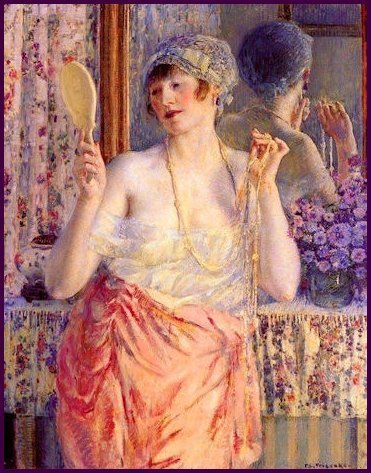
Portrait by Frederick Frieseke
I use this image on the right side of the perfumes page’s banner, under Author, where the description of this perfume will soon abide. The redhead with the mirror evokes Carmine in a contemplative mood, perhaps dreaming about a new lover.
To portray Carmine, Glenda Jackson around twenty-five would have been just about perfect, someone who could be warm or fierce, most definitely daring, with a sarcastic, snarky sense of humor. Or perhaps Ruth Wilson with her supple upper lip.
I hope this perfume captures a bit of Carmine’s playful bite but also the more romantic side she hides.
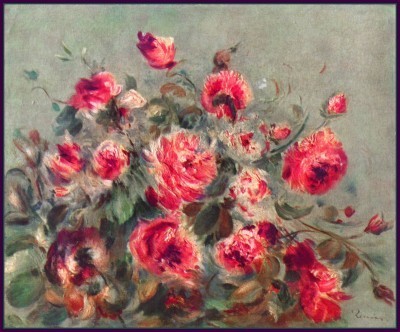
Roses by Renoir, jazzed up a bit by me.
To enter the Carmine giveaway, leave a response to the blog post that gives me a way to contact you if you win. Your email, Twitter handle, or your Facebook page to leave a message should all work.
For an extra entry, leave a separate post describing what perfume you imagine your favorite character might wear.
No age limit, but this giveaway will only be in the US, because of the hassle of mailing perfumes. Ditto, the bottle will be mailed to the winner by UPS. Entries accepted until midnight PST on Valentine’s Day. The next morning, the cats and I will play bat the winning entry to choose the winner. Official disclaimer below.
No other requirements, but I hope you’ll explore my ever-in-progress website and read an excerpt from my mystery.
This giveaway ends February 15 at 12 AM EST. Open to Residents of the USA only. Prize cannot be shipped to PO Boxes or overseas, only to locations where UPS delivers. Winner will be selected by the blogger and her pets and be notified by email. Winner have 48 hours to respond before a new winner is selected. The product offered for the giveaway is free of charge, no purchase necessary. Facebook, Twitter and Google+ are in no way associated with this giveaway, aside from the author promoting the giveaway on her pages. By providing your information in this form, you are providing your information to me and me alone. I do not share or sell information and will use any information only for the purpose of contacting the winner.
October 31, 2013
A Visit to Hell
I’m doing a guest appearance today at Elizabeth Caulfield Felt’s blog, with a Halloween tour of fin-de-siècle nightclubs. After your trip to L’Enfer, visit my website for a Halloween French lesson and another creepy tour – my new catacombs page.
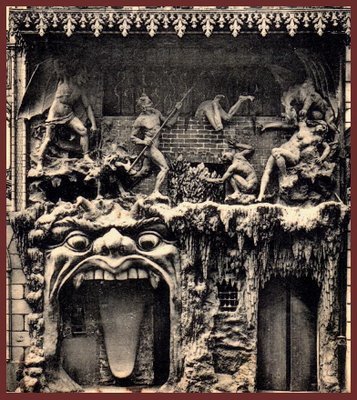
October 28, 2013
Halloween en français
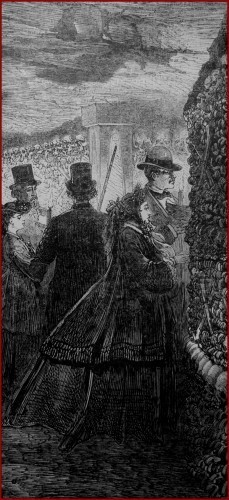
Victorian etching
Ont un Halloween Heureux! That’s what I’d like to say, since heureux co-mingles nicely with horreur in the ear, but Joyeux Halloween! is probably correct. I love Halloween, and in honor of the holiday, I’ve done a new page for my website about the catacombs. Click on one of les catacombes image in this post to visit it. Meanwhile, you can learn a little here about Halloween in the French style. I hope I’ve given you sufficient vocabulary. Vous serez surpris de voir à quel point beaucoup français vous savez déjà.
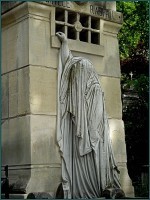
Tomb at Pere Lachaise
Par exemple, ici, c’est un tombeau au cimetière du Père Lachaise. Halloween is not a French holiday, but they’ve adopted it so les petits enfants can put on classic déguisements and get some bonbons. But the French have their own Day of the Dead, though it is far more somberly celebrated than in Mexico. November 1st is La Toussaint, or All Saint’s Day. Les cimetières are visited and chrysanthèmes left on the graves in magnificent displays praised as worthy of tourist visits.
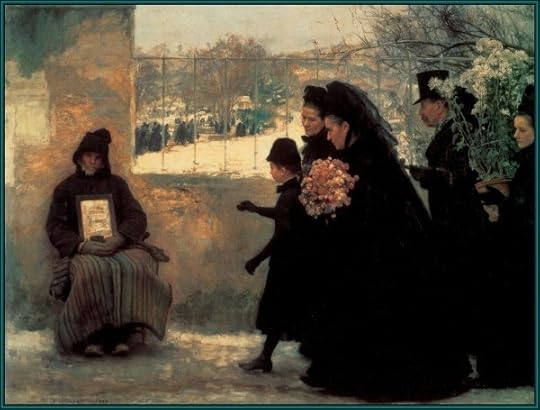
I’ve read that if you are ever invited to an automne dinner by a French family, you should not horrify your hostess by presenting her with a bouquet of chrysanthemums. Since one can find images of this lovely autumnal flower looking cheerful in vases, I can’t attest to the accuracy of this warning. More research is needed.
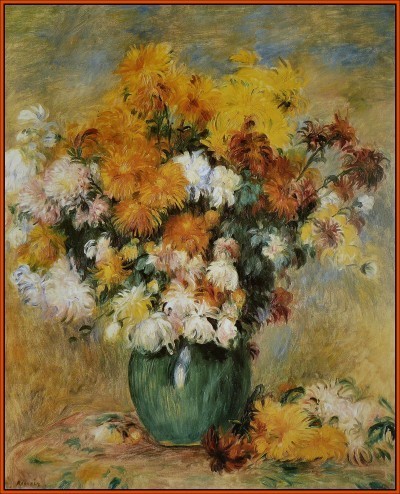
Bouquet of Chrysantemums by Renoir
However, I have assured myself that there will be a tarte à la citrouille, perhaps served by the light of un bougie. I saw many delicous recipes on the internet. One called for roasting the pumpkin first. Fascinating.

Pumpkin pie by candlelight. Photo from freshtopia.net
Bougie? I searched and found that this “wax candle” comes from Bugia, a town in Algeria with an ancient wax trade. Odd that bougie conjures Boogey(man), though not, in this case, boogie. According to Wikimedia: “The French equivalent of the Bogeyman is le croque-mitaine (“the mitten-biter” or rather “the hand-cruncher”, mitaine means mitt in an informal way).” Isn’t it very Russian to have a diminutive longer than the word? Apparently the Bogeyman is usually a deliberately vague and faceless personification of terror, and the same goes for the French version. There were no illustrations of a demonic figure crunching or munching gloved hands. I went in search of an image from one of those old Hollywood movies with crawling hand searching out a victim to throttle. No luck. I did find a lady in black leather “bondage mittens.” A bit kinky for this post? Then I found this “crime scene” photo. Rather too perfect to be real, and no mittens, but it’s quite striking.
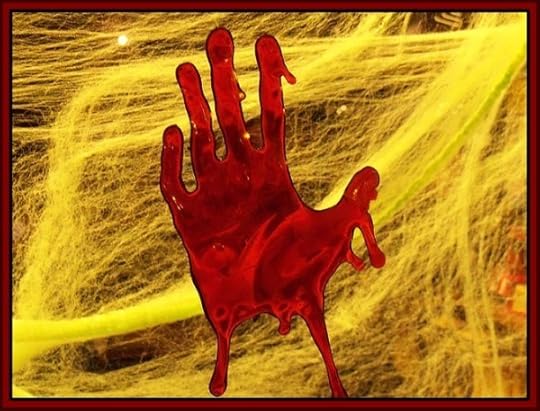
Original photo by JRLibby
So if French bougies come from Bugia, wence cometh candles? According to the online Etymology Dictionary: “Old English candel “lamp, lantern, candle,” an early ecclesiastical borrowing from Latin candela “a light, torch, candle made of tallow or wax,” from candere “to shine,” from PIE root *kand- “to glow, to shine, to shoot out light” (cf. Sanskrit cand- “to give light, shine,” candra- “shining, glowing, moon;” Greek kandaros “coal;” Welsh cann “white;” Middle Irish condud “fuel”).”
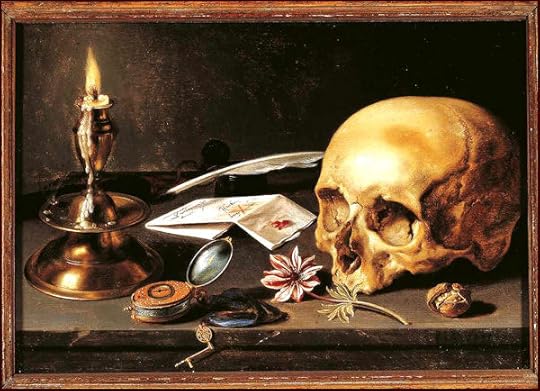
Vanitas by Pieter Claeszoon
And not only that! ”Candles were unknown in ancient Greece (where oil lamps sufficed), but common from early times among Romans and Etruscans. Candles on birthday cakes seems to have been originally a German custom. To hold a candle to originally meant “to help in a subordinate capacity,” from the notion of an assistant or apprentice holding a candle for light while the master works. To burn the candle at both ends is recorded from 1730.”
But back to Halloween… There are the usual costume possibilities. Various monstres are as popular there as they are here. Le Diable is always present. Terrifiants fantômes hanter le monde. Paris lays claim to one of the most famous fantômes .
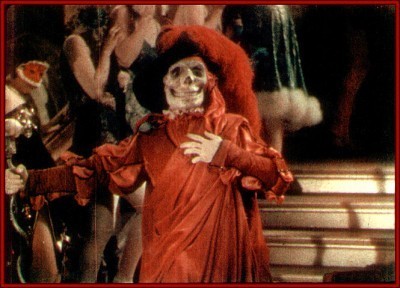
Phantom of the Opera
In 1884, this fashionable outfit was suggested if you wanted to be une sorcière.
She does not wear a masque, but she does hold un balai.
Elle a deux familiers. Un petit hibou perché sur son chapeau, et un chat noir rideaux ses épaules.
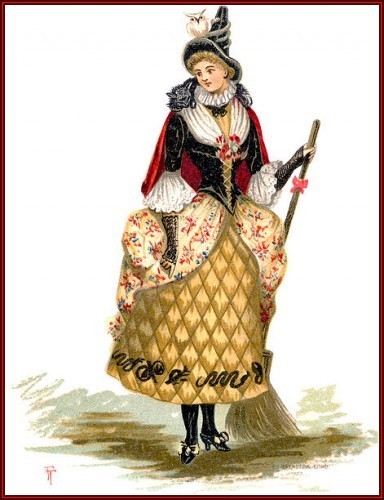
a witch
Toutefois, ce chat noir beau est beaucoup plus célèbre.
Il est le véritable symbole de la Butte Montmartre et la fin du siècle.
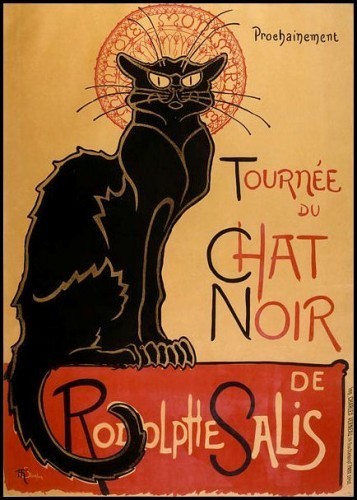
Vampires et autres créatures de la nuit, font leur apparition sur la scène.
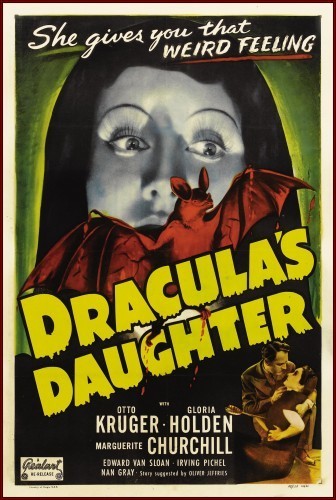
Old movie poster
The vampire in the picture has her own winged symbol.
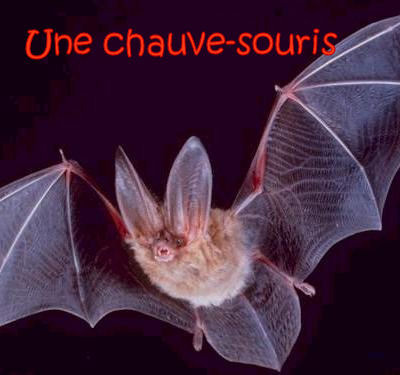
a bat
Une autre créature renvoyée par le royaume de la mort est la momie.
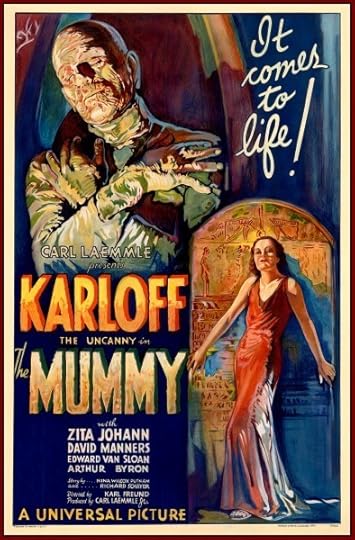
Classic cinema poster
Perhaps your jeune fille would like to be a zombie? C’est le même mot en anglais ou en français.

Dark Child by psyberartist
Or perhaps, you could design a chapeau avec un lutin, as in this strange illustration.
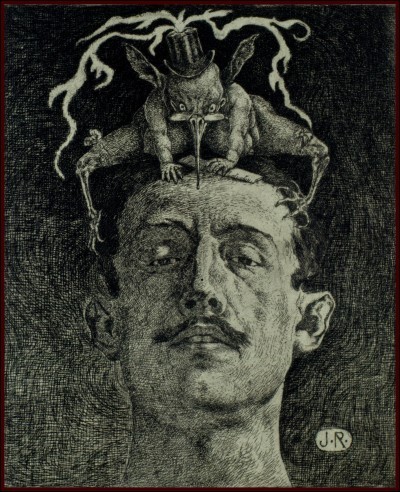
Man pecked by the goblin of criticism.
What other French words might you need for a proper Halloween?
Here’s an new one for me: un feu follet for a Jack O’Lantern.

Citroulle préparée pour Halloween by Carol Pasquier.
Also new and strange is un épouventail is a scarecrow.
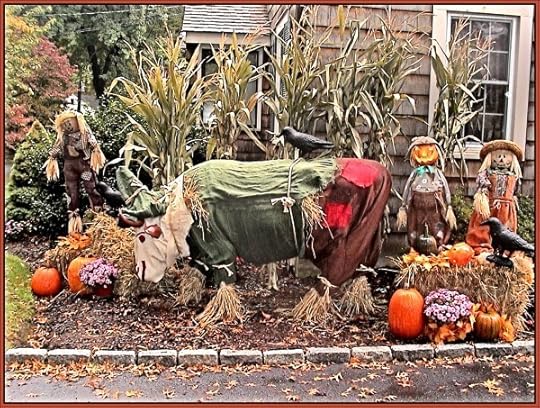
Gladys as a Scarecrow from James.lenbinski
For creepiness, we must needs have a creepy crawly critter.
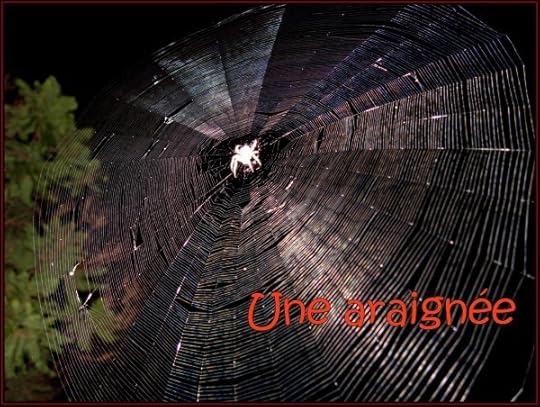
A spider in its web. Photo by Micael Hartl
And finally, a skeleton.
Most versatile, this mummified couple could be a zombie duo, or Death on a mount.
He holds a link to les catacombs. What better trip to take on Halloween?
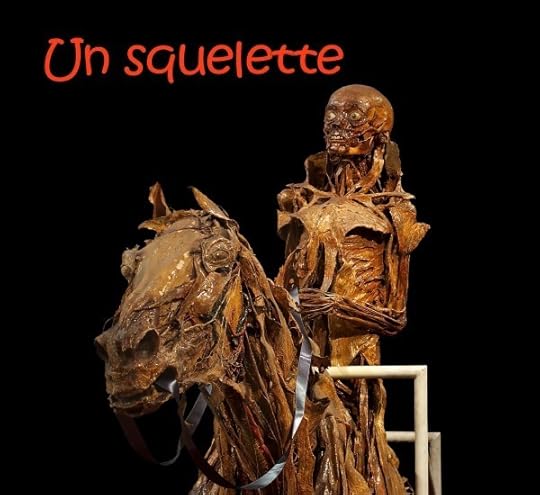
Photo by Jebulon
September 22, 2013
My One Paranormal Experience
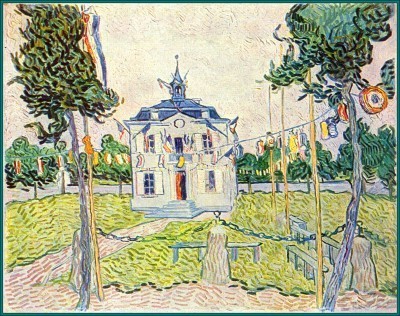
The Town Hall at Auvers-sur-Oise by Vincent Van Gogh
On my last visit to France, I made a return pilgrimage to Auvers-sur-Oise, a town a little to the north of Paris where Van Gogh spent the last three months of his life, and where he completed seventy-seven paintings. With all his conflicts and suffering, his productivity was amazing.
With me on this second visit was Sandra, my dear friend from Eugene, Oregon. For her it was not only the first trip to Auvers-sur-Oise, but to France. She wanted to spend most of her getting to know Paris, but I said we should see a small town as well. She loves Van Gogh, and the town is close, though the trains are finicky.

Sandra in the colorful tunnel leading to the train station.
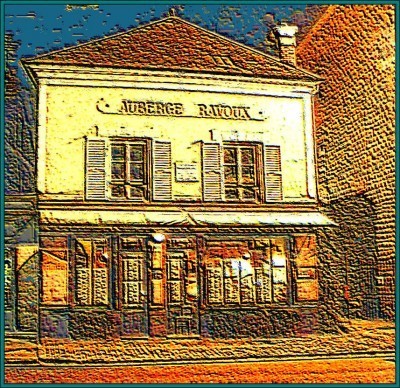
Stadtmusikant photo played with in Paintshop Pro for Impressionist effect.
It’s a charming town, with reproductions of Vincent’s art set about the sites he painted in the town and on the pathways leading to the wheat fields and the cemetery, and a museum in the Auberge Ravoux, the inn where he lived and died.
It was raining lightly in the morning and early afternoon, grey, wet, and cloudy, but not very cold. The greyness and rain proved an advantage for our venture into the tiny Vincent Van Gogh museum. There were no crowds of tourists this time, the building was all but empty! Most of the ground floor is taken up by the restaurant. There is a small gift shop on the premier étage (our 2nd floor), where you may buy tickets and memorabilia. The woman in charge explains that the room is mostly empty, but is very “emotional.”
And so you climb the stairs to the little attic room. The first time I was there, I expected to be moved to be in the room where Van Gogh had lived and died, but not with the weight and intensity I experienced as I climbed the stairs and entered the room. I was overwhelmed with grief. At first, I told myself that I was probably projecting my natural sadness at such an amazing life cut short with no recognition. But, in reflection, it felt like something that entered me rather than the familiar sensation of sadness welling from within.

Wikimedia photo by WvdV of the top of the stairs and Vincent’s room.
I was curious if I would feel a similar sensation again. For all my fascination with the occult, I don’t think I am particularly sensitive compared to many of my friends. But I felt the same sensation as I began climbing the staircase, even more intensely, for I was very aware of it as apart from me, a weight descending on me and filling me with devastating sorrow.
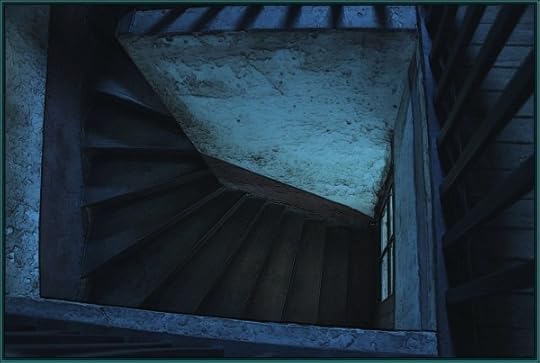
Wikimedia photo of Vincent’s stairs by WvdV, altered by me.
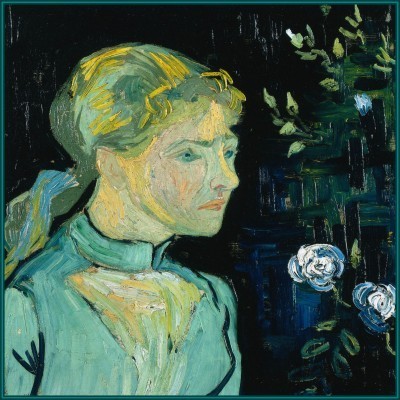
Vincent’s Portrait of Adelaine Ravoux
The few other people in the room did not seem to feel it—except for Sandra. We looked at each other and it was allwe could do not to burst into tears. The feeling went as soon as we left. There was only the lingering amazement at having felt so distraught, and the memories it stirred of Vincent’s difficult life. We felt our own sadness that his life ended so unhappily, but not this other weight of emotion. After his death, the room was never rented again, supposedly because the rooms of suicides are considered bad luck. But I wonder if other people did not feel that resident grief, and find it impossible to stay there. I believe what we experienced is known in the paranormal world as an imprint. I did not feel the presence of a person—a ghost—but of a despair that had penetrated that tiny room. There is controversy now whether Van Gogh committed suicide, or was the victim of an accidental shooting. There appears to be evidence both ways.
Down the hall is a larger room where we watched the movie they have about Auvers-sur-Oise and Vincent’s time there, with images of the art he painted, since the little town can’t afford to own one now.
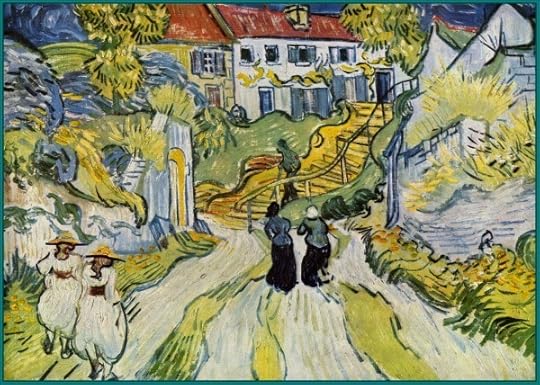
Click image for a list of the works Van Gogh did in Auvers-sur-Oise
One of the saddest moments I felt at the Auberge Ravoux was not Vincent’s room with its lingering imprint, but a quote in the restaurant of Van Gogh saying that perhaps, one day, he might have a show in a little cafe like this. That quote brought the far more familiar sense of sadness welling from within.
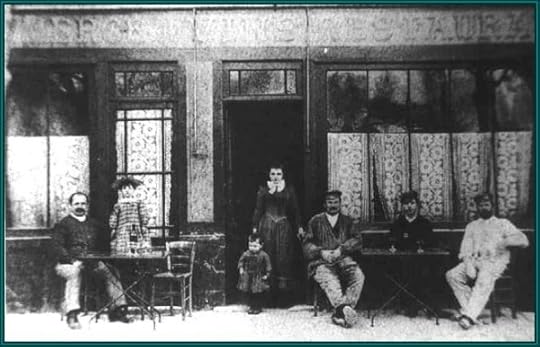
Though there were these moments touched with unhappiness, the visit to the town and the inn were overall positive and happy. Sandra and I had a good lunch in the café where Vincent ate (duck stew for me with potatoes, apples and cherries, fish stew for her). It was raining much harder during our meal, but the rain subdued to a sprinkle after.

The Auberge Ravoux restaurant.
After our pleasant lunch, we wandered through Auvers-Sur-Oise where Vincent did so many wonderful paintings. One of the most famous being the church.
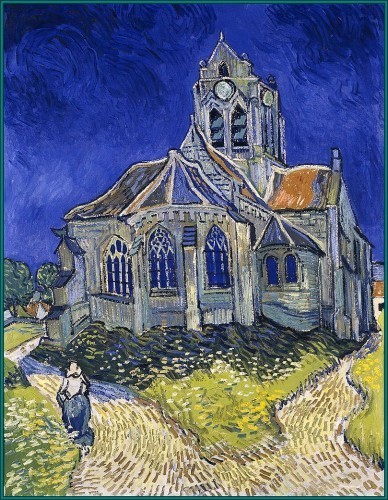
The Church at Auvers-sur-Oise.
In the pattering rain, we went on up past the church along the road to the cemetery.
 Beside the road you see the wheat fields he painted.
Beside the road you see the wheat fields he painted.
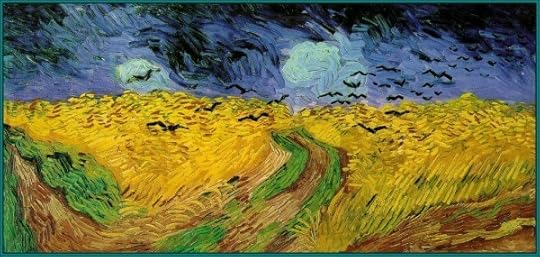
Wheat Field With Crows
Vincent is buried with his brother Theo beside him. Two simple white gravestones with lots of ivy growing over them. Sad, but in a peaceful way.
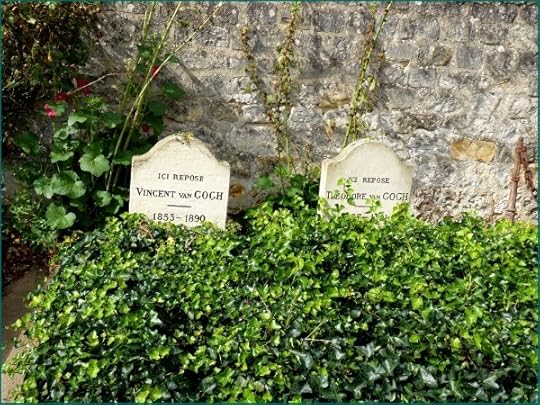
The gravestones of Vincent and Theo.
It’s a pretty cemetery, not very fancy but with a few nice memorials. There was one spectacularly cheerful one of another artist. I didn’t memorize his name, but the flat stone is covered with brilliant mosaics rather like Chagall, all very celebratory.

Close up of grave in the cemetery of Auvers-sur-Oise
When we left the cemetery to walk back to the town, the rain had departed, the sky was bright blue, filled with fluffy clouds, and the sun was shining bringing out all the colors of the leaves and flowers.

After passing through the magical mural underpass, we caught the last train back to Paris, after our sweet and sad day in Auvers-sur-Oise, the memory imprinted in our hearts.

Another wall of the mural.
Postscript:
There is a full day’s worth of adventures or more in Auvers-sur-Oise. The entire morning can be spent at the chateau where they have an Impressionist culture museum. Not paintings, but installations to let you experience a fragment of what life would have been like in the later 19th century. Click Van Gogh’s painting below to visit the site.
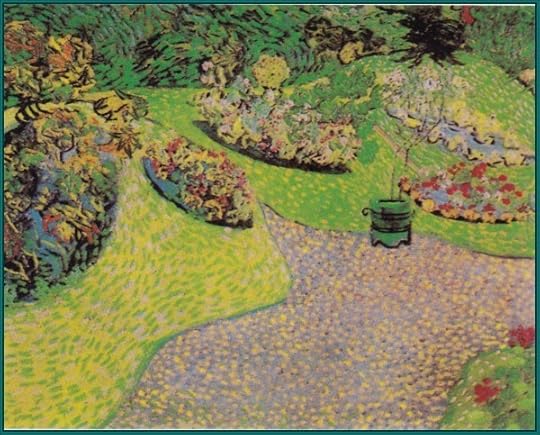
Garden in Auvers
During the 19th century, a number of painters lived and worked in Auvers-sur-Oise, including Charles-François Daubigny, Jean-Bapiste-Camille Corot, Camille Pissaro, Paul Cézanne, as well as Vincent Van Gogh. Daubigny’s house is now a museum where one can see murals painted on the walls by the artist, his family and friends, such as Honoré Daumier, and rooms decorated in period style.
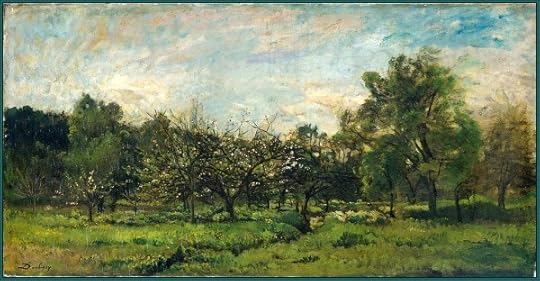
A landscape by Daubigny

Kittens in the Boudoir by Carl Reichert
The town does have a charming little museum which features the work of Daubigny and also of the school of Art Naif. We saw a wonderful collection which included many cats. Though none are available to show here, this image is similar, and there are others to be glimpsed on display at the Museum’s page. Click on the image to visit it.
All the above, Vincent’s museum, and one more delightful extra, a little Absinthe Museum filled with posters, historical information, and a collection of accoutrements for the absinthe ritual.
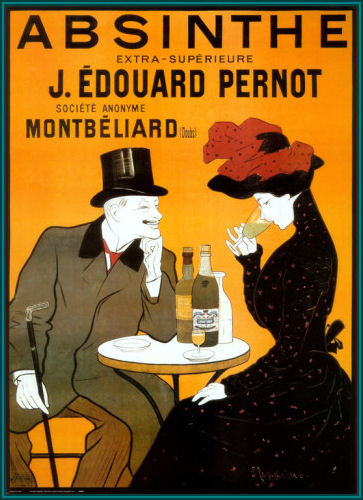
Click on the vintage poster to visit the museum.
There is more about the reign of the Green Fairy on the Absinthe page of my website, under the Revenants.
September 20, 2013
FOREVER – A cinematic visit to Père Lachaise Cemetery
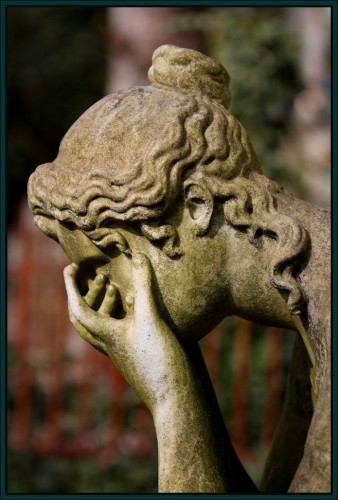
Pierre-Yves Beaudouin’s photo of Gareau tomb, from Wikimedia Commons
As a child, cemeteries filled me with a creepy, brooding horror and deep sorrow, long before I had a family member or pet die. There was a huge cemetery across from my grandmother’s house, and a small one next to an uncle’s home. I disliked them intensely and thought they should be hidden. I was not frightened of them – I did not want to accept death.
As I grew older, I became more detached about cemeteries and the inevitability of mortality. I also developed a love of the macabre so that I appreciated gloomy graveyard aesthetics, at least in the abstract But it wasn’t until I attended the University of Oregon in Eugene, that my feelings about them truly changed. There is a small cemetery on the campus, the Pioneer’s cemetery, that is old and charming.
The photo below looks rather more sprawling than the actual place, which is far cozier. It managed, with its green peacefulness and crumbling stones, to transform the grimness they usually evoked into a sad but contemplative peace.

Photo of Pioneer Graveyard in Eugene, by Another Believer
That contemplative peacefulness inhabits Heddy Honigmann’s exquisite documentary, FOREVER, set in the famous Père Lachaise cemetery in Paris.
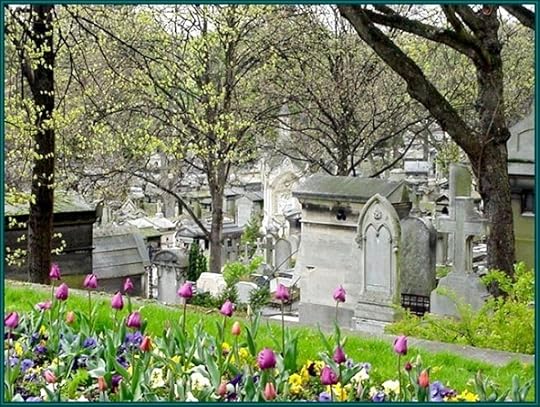
Lovely public domain image of Père Lachaise.
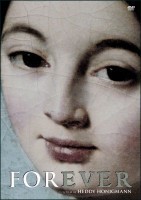
Cover of the DVD from a portrait by Ingres
From the very first time I watched it, I moved instantly into a calm, meditative space, filled with serenity yet still attuned to the poignant stories of love and loss that were related by the visitors to Père Lachaise. The main them is the inspiration that dead artists gift the living. The film is woven with several strands of , accented with separate stories. There is the thread of the pianist who remembers her father through playing Chopin.
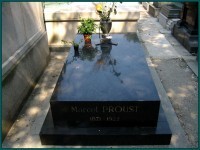
Photograph by Arnaud, from Wikimedia Commons
Proust is paid homage in expected and quite unexpected ways, beginning with the woman who comes to tend his grave (along with several other artists and poets). The first French group we see visit the grave because Proust is famous, but have read little or none of his work. But later, a young South Korean man tells us that he has come to Paris to visit Proust’s grave because he was so enamoured of In Search of Lost Time – having read it in Korean. My favorite is the artist who began by loathing Proust, came to love him a decade later, and to create an amazing homage (too good a surprise to spoil – see the film).
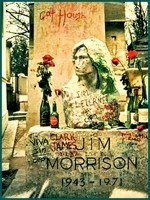
Jim Morrison’s gravesite, by LongLiveRock..
The search for Jim Morrison’s grave is a wry joke, for the rock star’s grave is never shown only pointed out with signs and directions to the stray seekers.
For a time, this was the most visited grave in the cemetery. He still receives visitors, but fewer now, who bring tributes of wine and rose.
The bust on the grave was first vandalized, then stolen.

Much-kissed verse on the back of Oscar Wilde’s tomb. Photo by Elizabeyth.
The most beloved site is the tomb of Oscar Wilde, though it has only a brief moment in the film, thousands of visitors come every year. Thousands added a lipstick kiss to the stone. Over the years, the oils and chemicals in the lipstick imprints were eroding the stone!
From The Ballad of Reading Gaol, the verse reads:
And alien tears will fill for him
Pity’s long unbroken urn
For his mourners will be outcast men
And outcasts always mourn
Today the tomb has been scrubbed and is surrounded by a (kissable) glass enclosure. The tomb, by Jacob Epstein, was suitably controversial in its day. Like Jim Morrison’s grave, it has been vandalized as well as kissed. In Wilde’s case, the testicles of the statue were removed. No one knows now where they are, though there was a rumor that the cemetery manager used them as a paperweight.
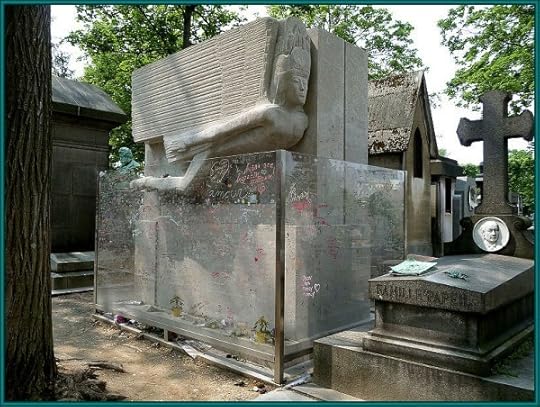
Oscar Wilde’s tomb – a public domain photo.

Photo of the Tomb of Chopin, generously given to Public Domain
The movie is filled with silence like an indrawn breath and with the elegiac whisper of leaves in the wind. But there is also music from both the living and the dead. The lovely Yoshino Kimura plays Chopin in honor of her father, Maria Callas sings of the heaven, an Iranian taxi driver offers one of the classic Persian songs that are his great love
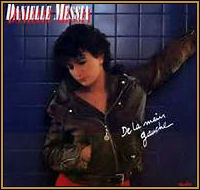
Click on the photo to hear her sing.
We also hear the haunting voice of the forgotten cabaret singer, Danielle Messia. She made only two albums, and died of cancer at 27.
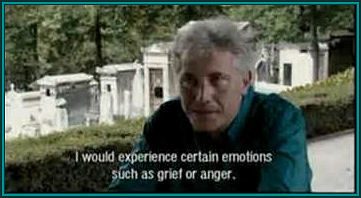
Bertrand speaks of his love of the cemetery.
She is the special favorite of one of the graveyard guides, Bertrand, with whom I fell a little in love. When he talked of Danielle Messia, he said he know of only one other visitor to her grave, a woman who once drove 300 miles to be with her on her birthday. He is quite eloquent in describing what the cemetery means to him.
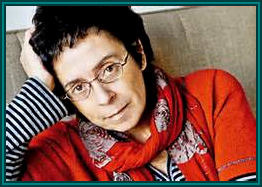
The director of Forever, Heddy Honnigman
Heddy Honigmann is the child of holocaust survivors. Born in Peru, she traveled widely and lives now as Dutch citizen. In Forever, she also includes stories of those who fled death, fled persecution—refugees who found sanctuary by journeying to Paris.
Not only artists are remembered, but also the husbands and lovers, the family members who shaped the lives of those who come to visit their resting place.
One of the most moving stories is that of a woman who found the love of her life in her fifties, a man twenty years longer. They had only three years of joy before he died, suddenly and strangely, from a bee sting. She tends his grave. The depth of her mourning is palpable, but so is the overwhelming intensity of her love. It is a testament to him, and also a gift to us.

Bee Fractalius 3 by nature photographer Fax Sinclair.
So there is sorrow in the movie, but also a gentle and pervasive joy. It captures perfectly Thornton Wilder’s quote, “The highest tribute to the dead is not grief, but gratitude.”
To see the trailer for Henny Honnigmann’s FOREVER, click on the image below.
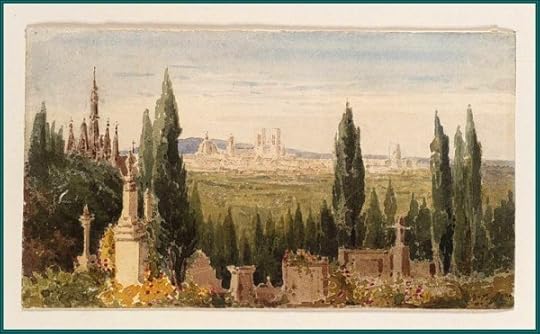
Early watercolor of Père Lachaise by Julia Emily Gordon
September 9, 2013
Double Bill: Casablanca and The English Patient
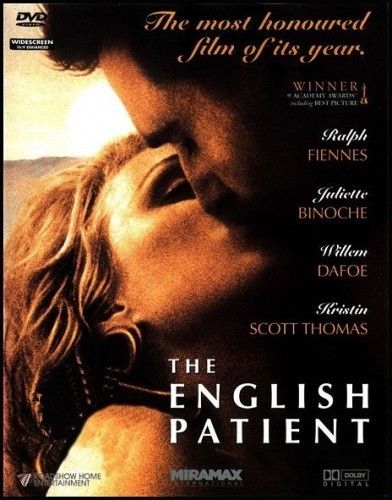
Poster for The English Patient
“The window was open. Gorgeous sunlight streamed in, and yet a wind seemed to blow, mournful, a wind that swept the fields of mortality for a hundred centuries.”
Those beautiful lines are from Murder As A Fine Art, the excellent historical thriller by David Morrell that I read recently. In it Thomas De Quincey describes being a child and going to see the body of his beloved sister, Elizabeth, and the sorrow he felt viewing her corpse. Reading them, I instantly thought of the film of The English Patient, and had to watch it again.
There is also a wind in early in The English Patient, blowing Katherine’s parachute shroud as Almásy flies the plane over the desert. But it is the desert, the vast and seemingly endless sand, that evokes the endless fields of mortality. Looking down on the golden undulating folds, the sculptured shadows, the desert conjures all the dead lovers of the world, forever anonymous, stretched out to eternity.
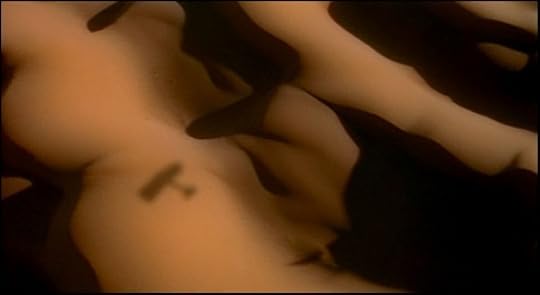
This is an incredible rich, subtle, and poignant film. The acting is marvelous, the script intelligent, the cinematography extraordinary. The English Patient is a feast for the eye, the mind, and the heart. I was mesmerized from the first shots of the brush strokes until the poignant end of the film. I found it deeply emotional, but in subtle and complex ways, and also a film that stirred up ideas.
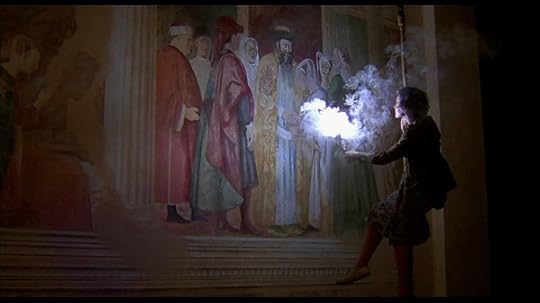
Hana shown the church by Kip.
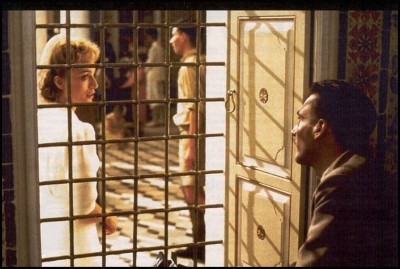
The Christmas party
Particularly fascinating is that Almásy makes the choice that Rick in Casablanca turns from. Though he had affection for his comrades, the count’s one great loyalty is to Katherine. Perhaps his love blinds him to the magnitude of his betrayal. Perhaps he chooses the German side because, as he says, the English made him their enemy. Perhaps, given the world of fallen kingdoms he has lived in, he only sees that thousands will die, one way or another, in this war that is just one of endless thousands of wars. Finally, he chooses the one over the many, and devotes himself to trying to save the only person he’s ever loved. It’s selfish, yet heart-breakingly human.
It’s a choice which commands a terrible price in his own and in other people’s lives–death, torture, suicide.
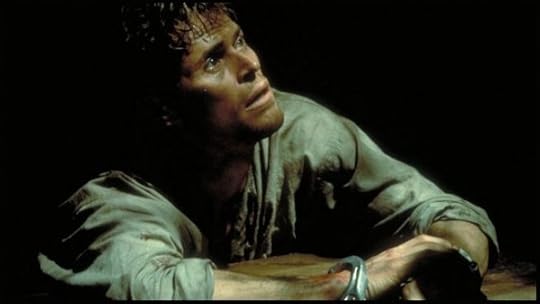
Willem Dafoe as Caravaggio.
It’s a hard choice to forgive, given how evil Hitler was, even if the count was as oblivious to that reality as he seems in the film. Since there was a real treasonous count with more mercenary motives, I’ve never understood why the character in the film wasn’t renamed. The Cliftons were, apparently, an English couple named the Claytons, so why not rename Almásy as well? He did not, after all, end his life as a crispy critter.
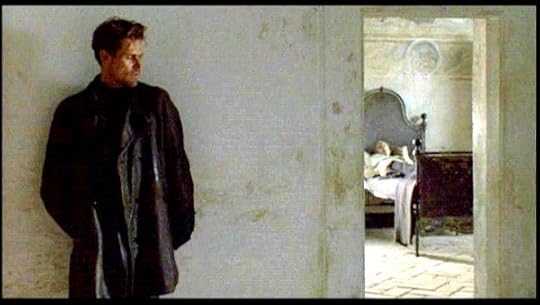
The English Patient not really a great romance. Katherine chooses duty over love (though duty was also Elsa’s first choice, it’s only when she sees Rick again that she succumbs to passion). Almásy, like Rick, dives into a bottle, but emerges to go on his desperate, fatal quest to save Katherine. As in Romeo and Juliet, it is his name which is her enemy. Cultural differences finally seem to sever the bond between Kip and Hana. Love does not conquer all, nor is its doom quite the same centerpiece that it is in Romeo and Juliet, though far more lives are consumed in the crucible of Almásy’s passion. Still, it is a great story about love, about passion, obsession, and human frailty.

On an even deeper level it evokes the inevitable currents of time. We begin in The Palace of the Winds, a cave so ancient we do not know the stories of those who painted their lives on its walls. Winds blow softly at the end, winds of motion, as the plane soars into the past, into death, and Hana leaving for her future in the truck. The trees flash past in a blur, and the breeze blows over her as she looks at the child who will one day be a woman, and have her own story of love and passion and sorrow.
I did read Michael Ondaatje’s novel, but don’t remember if Katherine’s words to the darkness were in the novel or only in the film.”
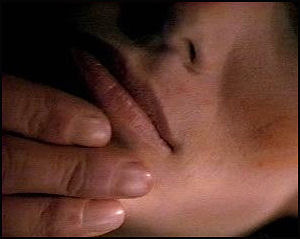
Marking Katherine’s body
“We die. We die rich with lovers and tribes, tastes we have swallowed, bodies we’ve entered and swum up like rivers. Fears we’ve hidden in – like this wretched cave.
I want all this marked on my body. Where the real countries are. Not boundaries drawn on maps with the names of powerful men. I know you’ll come carry me out to the Palace of Winds. That’s what I’ve wanted: to walk in such a place with you. With friends, on an earth without maps. The lamp has gone out and I’m writing in the darkness….”
Casablanca is on almost everyone’s favorite movie list. It shares a similar time frame and similar themes with The English Patient. It offers many of its protagonists the same choices.
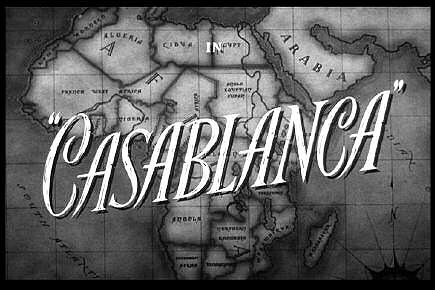
City of desperation….
If its darkness and pain are painted with lighter, broader strokes, still it has its share of desperation, thwarted love, betrayals, and broken dreams.
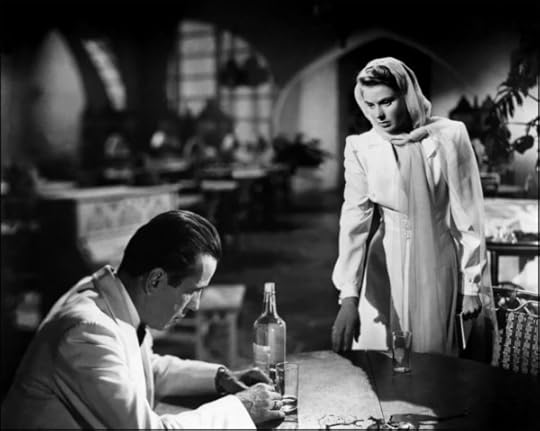
Refusing to forgive….
The film is such a perfect icon of Hollywood at its best, with its classy cast and witty dialogue, it’s stunning to discover that this pretty much flawless film was being filmed day to day with an unfinished script and that 3 directors were employed to give us the movie that we see as a whole.
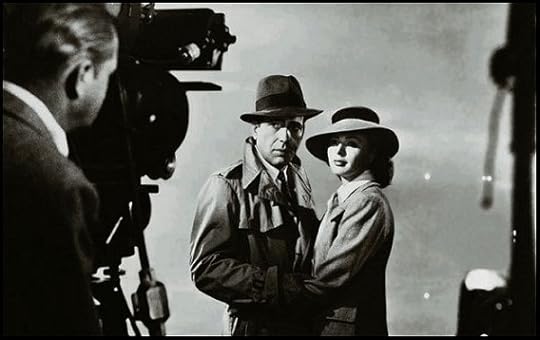
Filming the ending
It’s Hollywood in the 40′s, so it’s hard to believe that Rick wouldn’t have done the noble thing, but no one involved knew how it the story was going to end. Perhaps Rick might have tried to save Victor Laslo and failed. Laslo might have died heroically to protect his wife, and then Rick and Ilsa could have run off together. Laslo, noble fellow that he is, does not feel compelled to murder the wife who returned to him and the lover she abandoned, just because she really loves the other guy more. He knows he’s lucky to have her back.
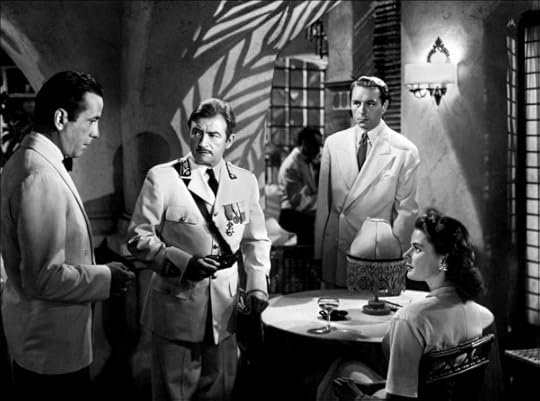
The future is uncertain…
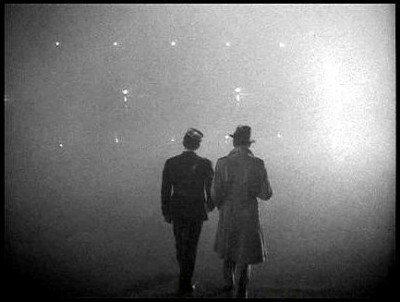
Although the cast was kept in suspense, Casablanca ended as it does, of course, with Rick and Captain Renault strolling off into history and their beautiful friendship.
Saving the world is more important than love….
But before that we get the “hill of beans” speech. It’s actually a moment I really, really dislike, not the idea, but that Rick preaches those beans to Ilsa, after all she’s been through and all the hard choices she’s made. I mean really…?
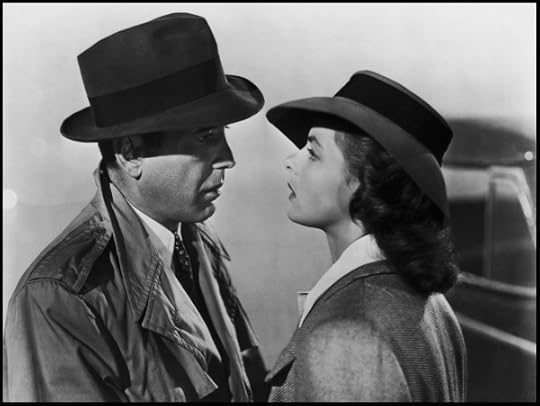
Love is just a hill of beans…
Unless we’re irredeemably cynical, we accept that some wars are worth fighting, and some causes worth dying for, though we’re too often sold a bill of goods about which wars those are. But stopping Hitler was one of those, whatever ugly stories may get unearthed amid the heroic ones.
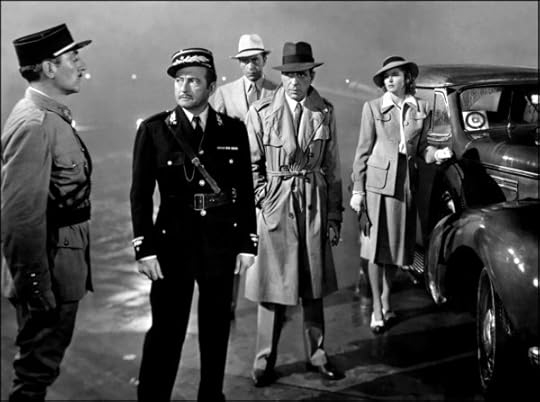
Fighting the good fight.
So Rick gives up Elsa and goes off to fight the war to end all wars (no…that was WWI, sorry). And we feel it’s right. As always in war there will be stories of loves that can’t be saved—but Rick and Elsa will always have Paris.
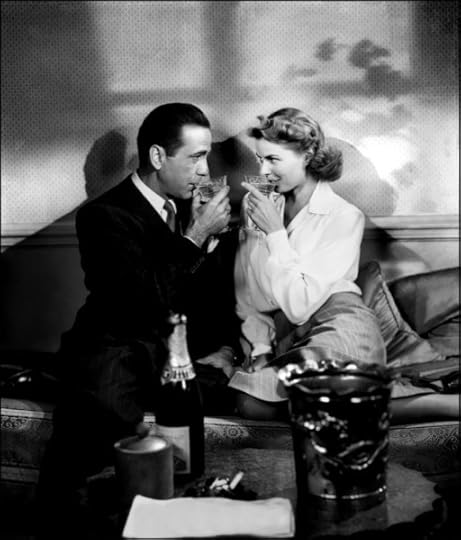
Postscript: I’ve been slowly replacing my DVDs with Blu Rays. In general, I’m choosing the most sumptuous ones first, or ones with a lot of special effects. Because the first couple of Blu Rays I got were far better than my DVDs, I assumed this would always be the case, but over time I found that perhaps only two thirds are better. Certainly enough films have shown significant improvement to continue my replacement policy, but it’s also disappointing that a few films show little improvement and a couple have actually been worse. That’s a long lead-in to say that Casablanca is one of the miracle transformations. It is unbelievably gorgeous in Blu Ray. Elsa’s jewels glitter. Rick’s Cafe American is filled with evanescent cigarette smoke, floating like lost dreams. Palm shadows weave an incredible backdrop to the action. It’s the favorite of all my Blu Rays.
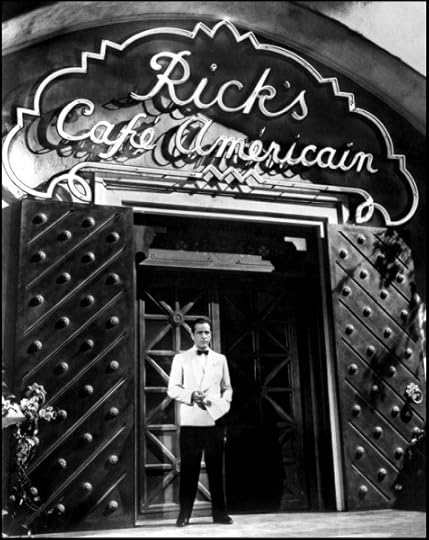
Welcome to Rick’s.



